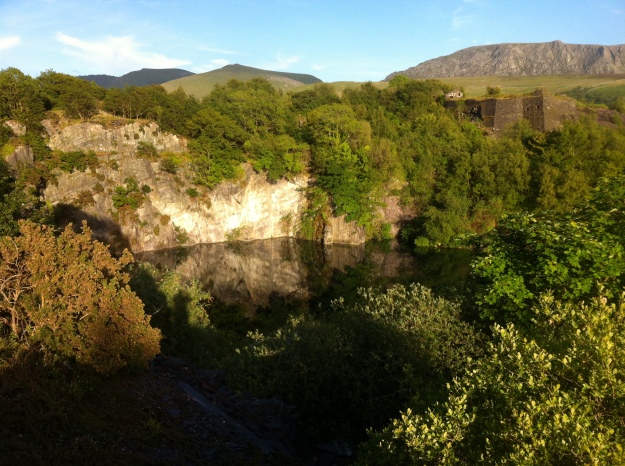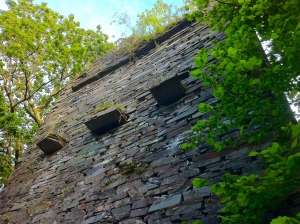 I recently spent some time in the derelict slate quarries in the Nantlle valley about 10 km west of Snowdon. I have been to this haunting place before and it continues to draw me.
I recently spent some time in the derelict slate quarries in the Nantlle valley about 10 km west of Snowdon. I have been to this haunting place before and it continues to draw me.
150 years ago Welsh quarries produced 99% of the world’s roofing slates, and Nantlle was one of the biggest. For a while this was a busy and prosperous place, but cheaper competition and the effect of two world wars led to a series of declines and eventual closure in 1977. What remains are huge opencast pits and mountainous piles of slate waste that seem forever poised, like suspended motion. Scattered amongst these are a fascinating and gothic array of houses, workshops, sheds, buttresses, bastions, walls and parapets – built entirely from slate. These are gradually slumping and sliding back into the ground from which they were dug, as if the rock was only briefly borrowed. As the quarrying declined nature began creeping back in and is now almost entirely in charge; stealthily covering the place with ferns, flowers, bushes and trees. By now the buildings appear like some lost Mayan city glimpsed between the foliage.
 These quarries are a strange no-man’s/every-man’s land, feral and self-willed; virtually unfenced and (mercifully) free of safety notices despite the precipices and rockslides. They are littered with bits of bonfires, old paint cans and relict cars. Around the back of a ruined house I found two garden plots fenced with pallets and old bedsprings, each contained neatly tended rows of potatoes.
These quarries are a strange no-man’s/every-man’s land, feral and self-willed; virtually unfenced and (mercifully) free of safety notices despite the precipices and rockslides. They are littered with bits of bonfires, old paint cans and relict cars. Around the back of a ruined house I found two garden plots fenced with pallets and old bedsprings, each contained neatly tended rows of potatoes.
In the middle of all this is a quarry called Dorothea: a colossal, straight-sided pit, a brutal scoop from the earth like a gouged eye-socket, now filled with deep black water. This water is 100 meters deep, and it is the depth that is so beloved of scuba divers. So beloved in fact that between 1994 and 2004 alone 21 of them died here. Whilst peering into these ominous waters I met a man who used to dive in Dorothea. He said “I can’t do it any more, I am too fat” but he was matter of fact about the deaths “They know the risks, they push it, we all did. It’s the depth and the cold that gets them.”
 Wanting to get away from the chill of Dorothea I scrambled up between the oaks, ash and sycamore growing on the slate piles, delighting in the way nature was re-clothing the scarred body of this place. A creeping cotoneaster was grabbing ground hand over fist, dozens of insects drawn to its sweet flowers. A green woodpecker called hysterically across the treetops and a willow warbler sang down the scale – a little half-heartedly by now. I feasted on wild strawberries, hanging like exotic earrings and ripe all the way round. There were casual gardens of wild flowers – stonecrop, birdsfoot trefoil, thyme, herb robert and clover – sprawling across the slate waste, grafting on a new skin ahead of the shrubs and trees that will surely follow.
Wanting to get away from the chill of Dorothea I scrambled up between the oaks, ash and sycamore growing on the slate piles, delighting in the way nature was re-clothing the scarred body of this place. A creeping cotoneaster was grabbing ground hand over fist, dozens of insects drawn to its sweet flowers. A green woodpecker called hysterically across the treetops and a willow warbler sang down the scale – a little half-heartedly by now. I feasted on wild strawberries, hanging like exotic earrings and ripe all the way round. There were casual gardens of wild flowers – stonecrop, birdsfoot trefoil, thyme, herb robert and clover – sprawling across the slate waste, grafting on a new skin ahead of the shrubs and trees that will surely follow.
 This odd ‘please yourself ‘ sort of a place can seem sinister and even dangerous and yet beautiful and benign too. Nobody seems to care what you think of it or how you use it and there probably isn’t enough money or the will to ‘do anything about it’. Meanwhile the trees steal forward.
This odd ‘please yourself ‘ sort of a place can seem sinister and even dangerous and yet beautiful and benign too. Nobody seems to care what you think of it or how you use it and there probably isn’t enough money or the will to ‘do anything about it’. Meanwhile the trees steal forward.
Thanks David
This is a beautiful piece of writing
xxxxx
Im SO pleased you liked it! Dx
Hi David, I think this is the best yet. I too have explored some of the “scarred places”, mostly round Llanberis,, but other abandoned industrial sites and old MOD installations round the coast, and love the way nature heals them over. Your piece perfectly balances a passionate interest in and detailed knowledge of the environment, human interaction – a nature piece with people in it!- and a profound awareness of mutability…all this is ‘only borrowed” . I love your spare use of adjectives and striking images, and the idea that these once guarded places become “everyone’s land”. I enjoyed it immensely.
Thank you Christine – SO encouraging. We will be arriving on Enlli on Saturday, winds and tide willing, so I do hope you will be there and we can catch up.